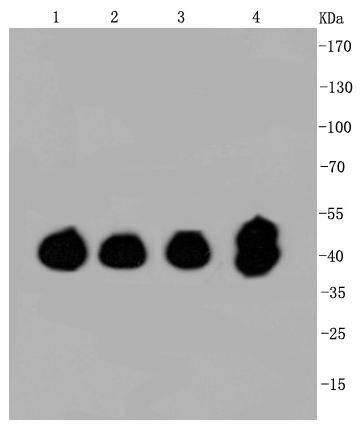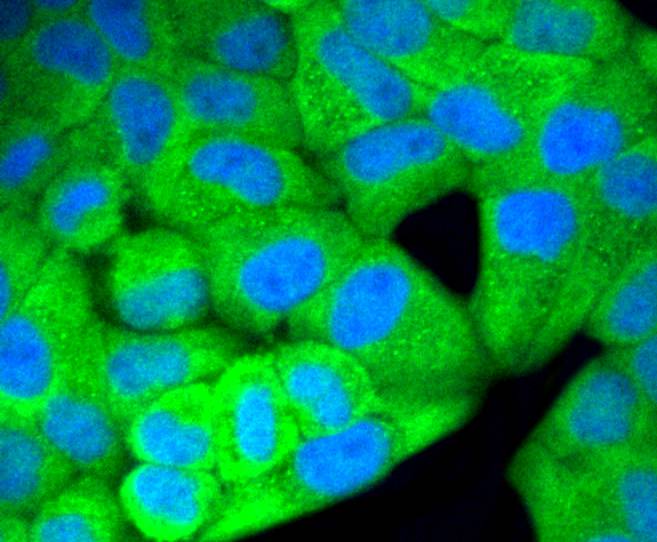Product Name :
ERK1/2 polyclonal antibody Background :
Mitogen-activated protein kinase (MAPK) signaling pathways involve two closely related MAP kinases, known as extracellular-signal-related kinase 1 (ERK 1, p44) and 2 (ERK 2, p42). Growth factors, steroid hormones, G protein-coupled receptor ligands and neurotransmitters can initiate MAPK signaling pathways. Activation of ERK 1 and ERK 2 requires phosphorylation by upstream kinases such as MAP kinasekinase (MEK), MEK kinase and Raf-1. ERK 1 and ERK 2 phosphorylation can occur at specific tyrosine and threonine sites mapping within consensus motifs that include the threonine-glutamate-tyrosine motif. ERK activation leads to dimerization with other ERKs and subsequent localization to the nucleus. Active ERK dimers phosphorylate serine and threonine residues on nuclear proteins and influence a host of responses that include proliferation, differentiation, transcription regulation and development. The human ERK 1 gene maps to chromosome 16p11.2 and encodes a 379 amino acid protein that shares 83% sequence identity to ERK 2. The human ERK2 gene maps to chromosome 22q11.21 and encodes a 360-amino acid protein. Product :
Rabbit IgG, 1mg/ml in PBS with 0.02% sodium azide, 50% glycerol, pH7.2 Storage&Stability :
Store at +4°C after thawing. Aliquot store at -20°C or -80°C. Avoid repeated freeze / thaw cycles. Specificity :
ERK1/2 polyclonal antibody detects endogenous levels of ERK1/2 protein. Immunogen :
recombinant protein Conjugate :
Unconjugated Modification :
Unmodification
ERK1/2 polyclonal antibody Background :
Mitogen-activated protein kinase (MAPK) signaling pathways involve two closely related MAP kinases, known as extracellular-signal-related kinase 1 (ERK 1, p44) and 2 (ERK 2, p42). Growth factors, steroid hormones, G protein-coupled receptor ligands and neurotransmitters can initiate MAPK signaling pathways. Activation of ERK 1 and ERK 2 requires phosphorylation by upstream kinases such as MAP kinasekinase (MEK), MEK kinase and Raf-1. ERK 1 and ERK 2 phosphorylation can occur at specific tyrosine and threonine sites mapping within consensus motifs that include the threonine-glutamate-tyrosine motif. ERK activation leads to dimerization with other ERKs and subsequent localization to the nucleus. Active ERK dimers phosphorylate serine and threonine residues on nuclear proteins and influence a host of responses that include proliferation, differentiation, transcription regulation and development. The human ERK 1 gene maps to chromosome 16p11.2 and encodes a 379 amino acid protein that shares 83% sequence identity to ERK 2. The human ERK2 gene maps to chromosome 22q11.21 and encodes a 360-amino acid protein. Product :
Rabbit IgG, 1mg/ml in PBS with 0.02% sodium azide, 50% glycerol, pH7.2 Storage&Stability :
Store at +4°C after thawing. Aliquot store at -20°C or -80°C. Avoid repeated freeze / thaw cycles. Specificity :
ERK1/2 polyclonal antibody detects endogenous levels of ERK1/2 protein. Immunogen :
recombinant protein Conjugate :
Unconjugated Modification :
Unmodification
-
 Western blot analysis of ERK1/2 on different cell lysates using anti-ERK1/2 antibody at 1/1,000 dilution. Positive control: Lane 1: Hela Lane 2: SW480 Lane 3: HCT116 Lane 4: PC12
Western blot analysis of ERK1/2 on different cell lysates using anti-ERK1/2 antibody at 1/1,000 dilution. Positive control: Lane 1: Hela Lane 2: SW480 Lane 3: HCT116 Lane 4: PC12 -
 ICC staining ERK1/2 in Hela cells (green). The nuclear counter stain is DAPI (blue). Cells were fixed in paraformaldehyde, permeabilised with 0.25% Triton X100/PBS.
ICC staining ERK1/2 in Hela cells (green). The nuclear counter stain is DAPI (blue). Cells were fixed in paraformaldehyde, permeabilised with 0.25% Triton X100/PBS.
Blood-brain barrier dysfunction induced by silica NPs in vitro and in vivo: Involvement of oxidative stress and Rho-kinase/JNK signaling pathways
PMCID: Pubmed No.:28081460
TLE3 represses colorectal cancer proliferation by inhibiting MAPK and AKT signaling pathways
PMCID: Pubmed No.:27669982
7-O-Geranylquercetin induces apoptosis in gastric cancer cells via ROS-MAPK mediated mitochondrial signaling pathway activation
PMCID: Pubmed No.:28076833
Isorhapontigenin induced cell growth inhibition and apoptosis by targeting EGFR-related pathways in prostate cancer
PMCID: Pubmed No.:28422286
Osteoinduction and long-term osseointegration promoted by combined effects of nitrogen and manganese elements in high nitrogen nickel-free stainless steel
PMCID: Pubmed No.:32262962
Acquisition of epithelial-mesenchymal transition phenotype in the tamoxifen-resistant breast cancer cell: a new role for G protein-coupled estrogen receptor in mediating tamoxifen resistance through cancer-associated fibroblast-derived fibronectin and β3-
PMCID: Pubmed No.:25990368
Korean Red Ginseng improves atopic dermatitis-like skin lesions by suppressing expression of proinflammatory cytokines and chemokines in vivo and in vitro
PMCID: Pubmed No.:28413317
Norisoboldine ameliorates DSS-induced ulcerative colitis in mice through induction of regulatory T cells in colons
PMCID: Pubmed No.:26363976
Triethylenetetramine Synergizes with Pharmacologic Ascorbic Acid in Hydrogen Peroxide Mediated Selective Toxicity to Breast Cancer Cell
PMCID: Pubmed No.:28280522
SP1-mediated microRNA-520d-5p suppresses tumor growth and metastasis in colorectal cancer by targeting CTHRC3
PMCID: Pubmed No.:26101709
17beta-estradiol promotes the odonto/osteogenic differentiation of stem cells from apical papilla via mitogen-activated protein kinase pathway
PMCID: Pubmed No.:25403930
Graphene/single-walled carbon nanotube hybrids promoting osteogenic differentiation of mesenchymal stem cells by activating p38 signaling pathway
PMCID: Pubmed No.:27799770
Estradiol induces HOTAIR levels via GPER-mediated miR-148a inhibition in breast cancer
PMCID: Pubmed No.:25928008
IGF-1/IGF-1R/ hsa-let-7c axis regulates the committed differentiation of stem cells from apical papilla
PMCID: Pubmed No.:27833148
The expression and function of miR-424 in infantile skin hemangioma and its mechanism
PMCID: Pubmed No.:28928430
Thalidomide Inhibits TGF-β1-induced Epithelial to Mesenchymal Transition in Alveolar Epithelial Cells via Smad-Dependent and Smad-Independent Signaling Pathways
PMCID: Pubmed No.:29116196
The Mammalian Target of Rapamycin and DNA methyltransferase 1 axis mediates vascular endothelial dysfunction in response to disturbed flow
PMCID: Pubmed No.:29118325
Effects of dietary methionine on breast muscle growth, myogenic gene expression and IGF-I signaling in fast- and slow-growing broilers
PMCID: Pubmed No.:28507342
TNF‐α downregulates CIDEC via MEK/ERK pathway in human adipocytes
PMCID: Pubmed No.:27062372
DGAEE, a newly synthesized derivative of glycyrrhetinic acid, potently attenuates mouse septic shock via its main metabolite DGA in an IL-10-dependent manner
PMCID: Pubmed No.:26456500
Epigallocatechin-3-gallate attenuates lipopolysaccharide-induced mastitis in rats via suppressing MAPK mediated inflammatory responses and oxidative stress
PMCID: Pubmed No.:25840281
Asiaticoside hinders the invasive growth of keloid fibroblasts through inhibition of the GDF‐9/MAPK/Smad pathway
PMCID: Pubmed No.:28346732
PM2.5-induced oxidative stress increases adhesion molecules expression in human endothelial cells through the ERK/AKT/NF-κB-dependent pathway
PMCID: Pubmed No.:25876056
Outer Membrane Protein 27 of Brucella Activates Mitogen-Activated Protein Kinase Signal Pathway in Human Trophoblast Cells
PMCID: Pubmed No.:29326958
Overexpression of miR-335 confers cell proliferation and tumour growth to colorectal carcinoma cells
PMCID: Pubmed No.:26708214
Resokaempferol-mediated anti-inflammatory effects on activated macrophages via the inhibition of JAK2/STAT3, NF-κB and JNK/p38 MAPK signaling pathways
PMCID: Pubmed No.:27261558
Chrysin alleviates allergic inflammation and airway remodeling in a murine model of chronic asthma
PMCID: Pubmed No.:26780233
Biochanin A Protects Against Lipopolysaccharide-Induced Damage of Dopaminergic Neurons Both In Vivo and In Vitro via Inhibition of Microglial Activation
PMCID: Pubmed No.:27417698
Naringin prevents carbon tetrachloride-induced acute liver injury in mice
PMCID: Pubmed No.:36559593
Potent effects of dioscin against thioacetamide-induced liver fibrosis through attenuating oxidative stress in turn inhibiting inflammation, TGF-β/Smad and MAPK signaling pathways
PMCID: Pubmed No.:28070230
Dioscin suppresses human laryngeal cancer cells growth via induction of cell-cycle arrest and MAPK-mediated mitochondrial-derived apoptosis and inhibition of tumor invasion
PMCID: Pubmed No.:26849940
Daphnetin reduces endotoxin lethality in mice and decreases LPS-induced inflammation in Raw264.7 cells via suppressing JAK/STATs activation and ROS production
PMCID: Pubmed No.:28409189
Disrupting nNOS-PSD-95 coupling in the hippocampal dentate gyrus promotes extinction memory retrieval
PMCID: Pubmed No.:28888982
Annosquacin B induces mitochondrial apoptosis in multidrug resistant human breast cancer cell line MCF-7/ADR through selectively modulating MAPKs pathways
PMCID: Pubmed No.:27450387
Knockdown of Astrocyte Elevated Gene-1 Inhibits Activation of Hepatic Stellate Cells
PMCID: Pubmed No.:26879903
Effects of Ixeris dentata water extract and caffeic acid on allergic inflammation in vivo and in vitro
PMCID: Pubmed No.:26104582
Increased Thymic Cell Turnover under Boron Stress May Bypass TLR3/4 Pathway in African Ostrich
PMCID: Pubmed No.:26053067
MSTN, mTOR and FoxO4 Are Involved in the Enhancement of Breast Muscle Growth by Methionine in Broilers with Lower Hatching Weight
PMCID: Pubmed No.:25437444
Evidence for a role of GPRC6A in prostate cancer metastasis based on case-control and in vitro analyses.
PMCID: Pubmed No.:27338047
M3 receptor is involved in the effect of penehyclidine hydrochloride reduced endothelial injury in LPS-stimulated human pulmonary microvascular endothelial cell
PMCID: Pubmed No.:29158153
Heparin-Binding Epidermal Growth Factor-Like Growth Factor Enhances Aquaporin 3 Expression and Function During Mouse Embryo Implantation
PMCID: Pubmed No.:27436370
MicroRNA-9 regulates cardiac fibrosis by targeting PDGFR-β in rats
PMCID: Pubmed No.:26896308
Effects of selenium on the proliferation, apoptosis and testosterone production of sheep Leydig cells in vitro
PMCID: Pubmed No.:28257863
Reduced β‑2‑glycoprotein І inhibits hypoxia‑induced retinal angiogenesis in neonatal mice through the vascular endothelial growth factor pathway
PMCID: Pubmed No.:25374014
The Inhibitory Effect of Eplerenone on Cell Proliferation in the Contralateral Kidneys of Rats with Unilateral Ureteral Obstruction
PMCID: Pubmed No.:28402979
Insulin-like growth factor 1 promotes the proliferation and committed differentiation of human dental pulp stem cells through MAPK pathways
PMCID: Pubmed No.:27573439
Local renin-angiotensin system regulates hypoxia-induced vascular endothelial growth factor synthesis in mesenchymal stem cells
PMCID: Pubmed No.:26045756
Increased expression of EHF contributes to thyroid tumorigenesis through transcriptionally regulating HER2 and HER3
PMCID: Pubmed No.:27517321
N-cadherin promotes thyroid tumorigenesis through modulating major signaling pathways
PMCID: Pubmed No.:28042956
Identification of MAP kinase pathways as therapeutic targets in gallbladder carcinoma using targeted parallel sequencing
PMCID: Pubmed No.:28422736
4,4′-diaponeurosporene, a C30 carotenoid, effectively activates dendritic cells via CD36 and NF-κB signaling in a ROS independent manner
PMCID: Pubmed No.:27276712
STIM1 plays an important role in TGF-β-induced suppression of breast cancer cell proliferation
PMCID: Pubmed No.:26919241
SiRNA Directed Against Annexin II Receptor Inhibits Angiogenesis via Suppressing MMP2 and MMP9 Expression
PMCID: Pubmed No.:25633185
Sulforaphane inhibits thyroid cancer cell growth and invasiveness through the reactive oxygen species-dependent pathway
PMCID: Pubmed No.:26312762
Inhibition of IL-8-mediated endothelial adhesion, VSMCs proliferation and migration by siRNA-TMEM98 suggests TMEM98's emerging role in atherosclerosis
PMCID: Pubmed No.:29152140
Epigallocatechin-3-gallate attenuates lipopolysaccharide-induced mastitis in rats via suppressing MAPK mediated inflammatory responses and oxidative stress
PMCID: Pubmed No.:25840281
Hypoxia-induced apoptosis is blocked by adrenomedullin via upregulation of Bcl-2 in human osteosarcoma cells
PMCID: Pubmed No.:26035796
Ruscogenin suppresses mouse neutrophil activation: Involvement of protein kinase A pathway
PMCID: Pubmed No.:26134424
Role of the MAPK pathway in the observed bystander effect in lymphocytes co-cultured with macrophages irradiated with γ-rays or carbon ions
PMCID: Pubmed No.:25748424
GPER promotes tamoxifen-resistance in ER+ breast cancer cells by reduced Bim proteins through MAPK/Erk-TRIM2 signaling axis
PMCID: Pubmed No.:28902352
GPR30-mediated HMGB1 upregulation in CAFs induces autophagy and tamoxifen resistance in ERα-positive breast cancer cells
PMCID: Pubmed No.:34182538
Bioworld Biotech only provide peptides for our antibodies and do not provide additional peptide customization services.
Price/Size :
USD 368/1mg/vial
Tips:
For phospho antibody, we provide phospho peptide(0.5mg) and non-phospho peptide(0.5mg).Describe :
Blocking peptides are peptides that bind specifically to the target antibody and block antibody binding. These peptide usually contains the epitope recognized by the antibody. Antibodies bound to the blocking peptide no longer bind to the epitope on the target protein. This mechanism is useful when non-specific binding is an issue, for example, in Western blotting (WB) and Immunohistochemistry (IHC). By comparing the staining from the blocked antibody versus the antibody alone, one can see which staining is specific; Specific binding will be absent from the western blot or IHC performed with the neutralized antibody.Formula:
Synthetic peptide was lyophilized with 100% acetonitrile and is supplied as a powder. Reconstitute with 0.1 ml DI water for a final concentration of 10 mg/ml.The purity is >90%,tested by HPLC and MS.
Storage:
The freeze-dried powder is more stable. For short time at 2-8°C. For long term storage store at -20°C.
Note :
This product is for research use only (RUO only). Not for use in diagnostic or therapeutic procedures.
 ERK1/2 polyclonal antibody
ERK1/2 polyclonal antibody  Datasheet
Datasheet COA
COA MSDS
MSDS SHIP
SHIP